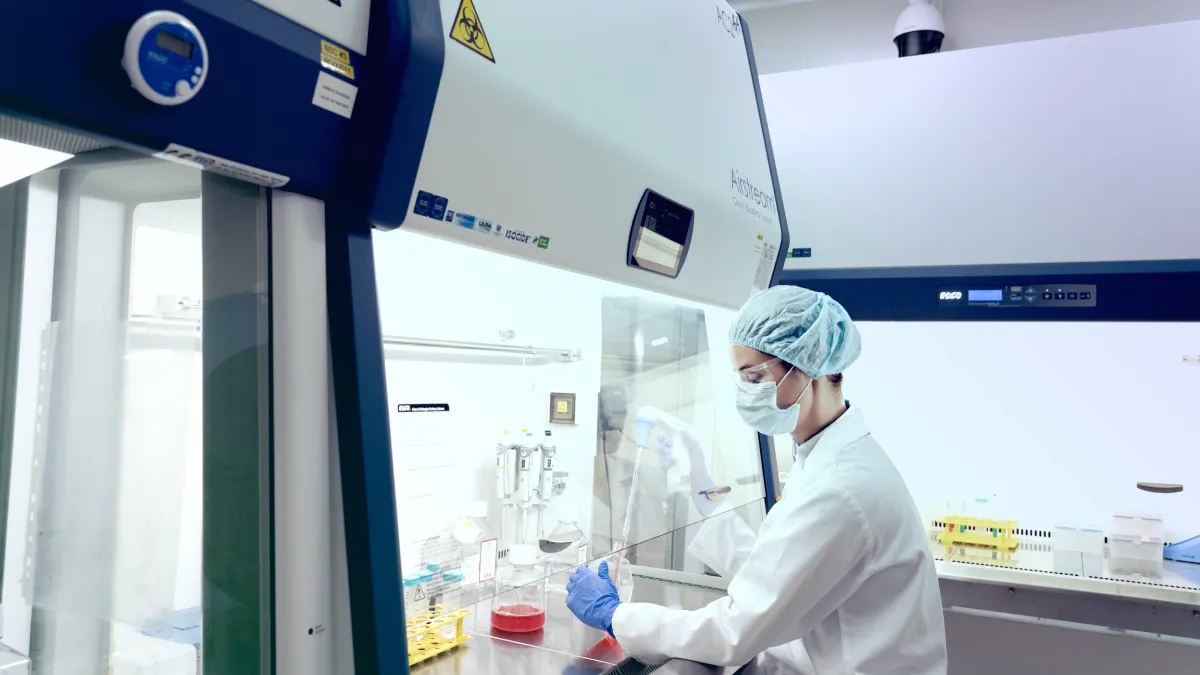VacciXcell’s TideCell® System takes vaccine production to a higher level, with new enhanced features and more options for better flexibility. Users can choose between single-use and multiple-use and different capacities and options for the different components of the TideCell® system.
The basic components of the TideCell® are the TideCell® Incubation and the TideCell® Mixer; the TideCell® Incubation system holds matrix vessel, where cell cultivation takes places, while the TideCell® Mixer holds the culture medium.
VacciXcell’s TideCell® System offers several key benefits and overcomes problems associated with other adherent bioreactor systems. First, the TideCell® Incubation System has new features including ULPA-filtration system and optional biovap hydrogen peroxide biodecontamination system. The inlet air to ULPA-filtered to ensure good air quality in the system, while the exhaust air is ULPA-filtered to protect operators and the environment from BSL3/4 viruses. The biovap is an auxiliary system for enhanced decontamination of the incubation system. These additional features enhance operator and environment protection.

Second, TideCell® eliminates shear stress, which happens with cells grown in stirred tank bioreactors. High shear stress can cause cells to die, leading to lower cell yield and increased downstream costs due to high cell debris. In the TideCell® System, cells do not experience shear stress, as there is no agitation in the matrix vessel and the gentle vertical oscillation does not lead to shear stress either.
Third, separation of the matrix vessel from culture media overcomes the problems associated with bubbling and foaming. Agitation, which homogenizes culture media, often causes foaming; when foaming takes place, anti-foam reagent is added, which may affect cell growth and development. On the other hand, bubbles are entrapped oxygen delivered by the sparger; bubbles can entrap cells and even kill cells when they burst. Cells grown with the TideCell® system are not at risk with the problems caused by bubbling and foaming, as medium homogenization is done in a separate vessel, as that of the cultivation vessel. VacciXcell provides more options for users by offering 3 different types of mixing systems.



Table 1. TideCell® Mixing System Options
| Mixing System | Magnetic Stirring System | Recirculation Thermostatic Mixing System | Stir Tank Mixing System |
| Single/Multiple Use | Multiple use | Single use | Multiple use |
| Container volume | 10L, 20L | 50, 100, 200, 500, 1000L | 30, 50, 100, 200, 500, 1000L |
| Material | Glass vessel | PP bag | Stainless Steel 316 Vessel |
| Incubation system | 2L matrix vessel | 2 – 100L matrix vessel | 2 – 100L matrix vessel |
Fifth, the TideCell® System eliminates oxygen limitation and channeling effect typically present in other packed bed bioreactor systems. In other bioreactor systems, oxygen transfer takes place from the air to the culture medium (in the form of bubbles) to the cells; this 3-step oxygen transfer can be slow and can limit oxygenation of the cells. On the other hand, the channeling effect creates deadzones, which affect the homogeneity of the culture system. The TideCell® System eliminates both these problems. The TideCell® overcomes oxygen limitation in several ways. First, the direct exposure of cells to oxygen during the aeration phase leads to a faster oxygen uptake. Second, TideCell® employs a dual oxygenation scheme, wherein cells can take up oxygen during the aeration phase and as well as during nutrition phase via the dissolved oxygen in the culture medium. Finally, the matrix surface area directly exposed to aeration increases linearly with volume, thus oxygen uptake is not limited during scale-up. On the other hand, TideCell®’s dual direction emerge and submerge motion eliminates the channelling effect, thereby maintaining a homogeneous matrix vessel.
Finally, the TideCell® System has been successfully used for the production of different human and animal vaccines with different cell lines. It is currently being used as the production platform for commercially available HepA vaccine and as well as human rabies vaccine.
Table 2. Cell lines and viruses produced with the TideCell® System
| Cell Line | Virus Strain | Cell Density | Virus Titer |
| VERO | JEV(Beijing strain) | 4.6 x 107 | 109pfu/ml |
| VERO | Rabies virus | 4.0 x 107 | 108 IgLD50/ml |
| VERO | Enterovirus type 71 | 2.6 x 107 | 107.8 TCID50/ml |
| MDCK | H5N1 | 2.3 x 107 | HA=1024~2048 |
| MDCK | A(H1N1) | 2.2 x 107 | HA=512~1024 |
| PK | Hog Cholera | 3.7 x 107 | 106.5pfu/ml |
| ST | Hog Cholera | 2 x 107 | 2 mil. RID |
| CEF | WEE | 4 x 107 | 109pfu/ml |
| BHK-21 | Rabies | 4.5 x1 07 | 108.5 TCID50/ml |
| BHK-21 | Pseudorabies | 2.35 x 107 | 108.8 TCID50/ml |
| MDBK | Cow vaccine | 1.29 x 107 | 109.2 TCID50/ml |
| HEK-293 | Adenovirus | 3.5 x 107 | 108pfu/ml |
| SF-9 | Baculovirus | 6 x 107 | 109pfu/ml |
| Marc145 | PRRSV | 1.16 x 107 | 108.29TCID50/mL |
| GL 37 | Hepatitis A virus | 2.3 x 107 | 0.5 mg/109 cells |
Finally, VacciXcell’s TideCell® System is the only pilot/production scale system that can be placed in a cGMP isolator; this allows the production of wild-type and BSL3/4 viruses, without the risk of operator exposure and accidental leak to the environment. Wild-type viruses are needed for vaccine production for seasonal influenza and pandemic outbreaks such as MERS-Cov and Ebola.

Sign up to our newsletter and receive the latest news and updates about our products!
